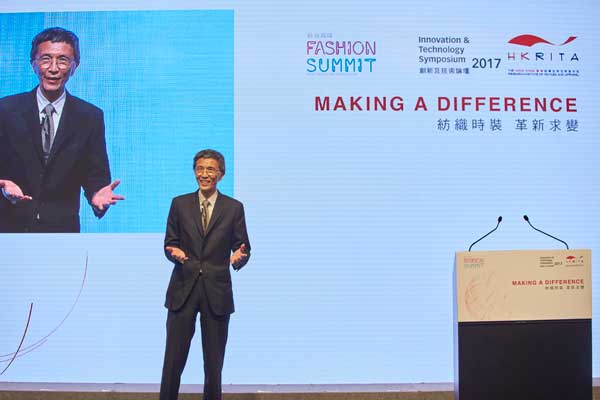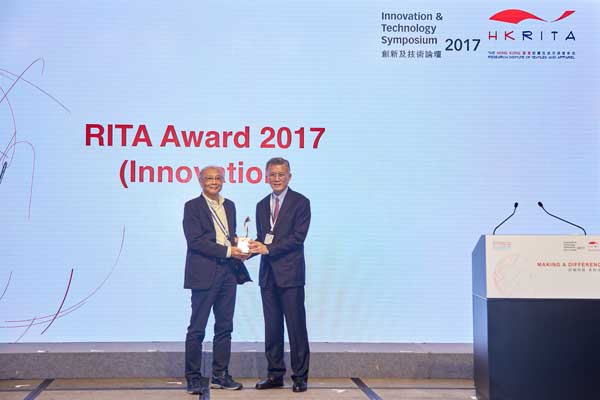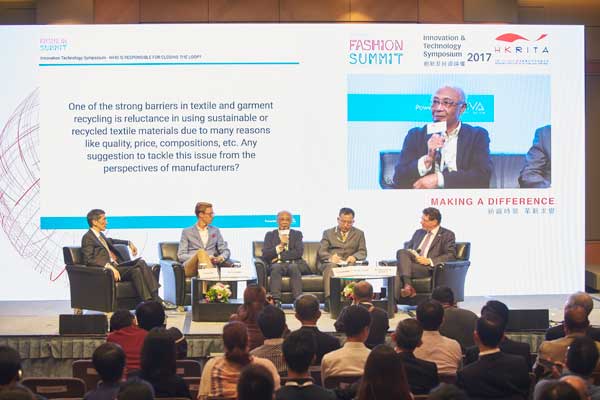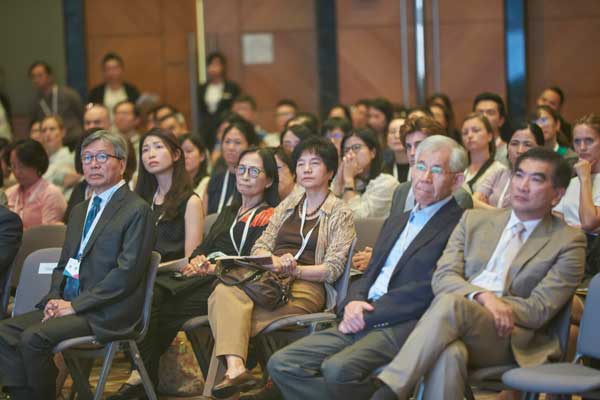FW
Nepal Yarn and Textile Expo is being held September 15 to 19, 2017. The expo will showcase a range of textile products like cloths, knitted and hosiery products including machinery. There are altogether 55 stalls displaying locally produced textiles and garments.
Nepal’s textile sector, which is mostly cotton and synthetic based, is passing through a tough phase. A large number of textile factories in Nepal have either closed down or are on the verge of closure due to labor unrest, high taxes, unclear government policies etc.
Nepal charges customs and VAT duties on imports of polyester fabric from India in excess of 32 per cent. Against this, Nepal has provided tax relief to fabrics and garments exported by China which attract only 17 per cent duty. Nepal is strong consumer of polyester fabric. The textile sector in Nepal includes manufacturing of yarn, Jute, Woolen carpets, Garments, Pashmina and Cotton terry towels. These are also major exports from the country. Textile and yarn are more important for the local domestic market.
Jute farming and manufacturing used to be the main cash crop and exportable industrial product till the early 1970s but economic viability could not be maintained in the face of cheap substitutes like plastic. Jute now contributes only marginally to the economy.
Gujarat is witnessing a sharp decline in forward contract of cotton for export in the new season. This is because exporters have had bad experiences in the past few years and faced losses due to advance commitment of cotton buying. Gujarat, a leading cotton producing state has sown cotton on 2.63 million hectares as on September 4 as against 2.38 million hectares in the corresponding period of 2016. Gujarat accounts for a 25 to 30 per cent share in India’s cotton exports.
Usually a month before the new season, exporters commit advance orders with ginners and cotton suppliers for exports in November and December. However, in view of unfavorable experiences in recent years, exporters are not taking risks in forward contracts resulting in virtually no forward contracts this year.
Good monsoon has increased cotton sowing by almost 18 per cent nationally and 10.50 per cent in Gujarat. Higher sowing has brightened the expectation of better production. India will remain the world’s largest cotton producer in 2017-18 with a four per cent increase in output. The country has exported six million bales of cotton so far during cotton year 2016-17. Cotton production in the US is forecast to increase by 20 per cent.
Fashion Switch is an initiative of the British Fashion Council to encourage brands and businesses to increase demand for green energy, helping to accelerate investment and the rate and scale of renewables in the UK.
A number of companies have already signed up, including Kering, Selfridges, Belstaff, E Tautz, Christopher Raeburn and Stella McCartney. The scheme gives brands advice on negotiating contracts with green energy suppliers as well as operating on an information-sharing basis where smaller brands can benefit from the sustainable knowhow of bigger organisations like Marks & Spencer. Knowledge will be shared in a series of easily digestible guides.
The project comes amid renewed focus on climate change both globally and within the fashion industry. The Paris Agreement — the biggest agreement to date — is set to commence in 2020. The US’ withdrawal from the agreement has sparked many conversations about the importance of taking action to reduce carbon emissions: brands including Nike, Adidas, Lululemon and The North Face have all rallied against the decision.
Formed in 1983, British Fashion Council is a not-for-profit organisation that aims to further the interests of the British fashion industry and its designer businesses by harnessing and sharing collective knowledge, experience and resources of the sector.
New York Denim Days will be held September 29 to October 1. The show will connect denim insiders, designers and brands to consumers at an immersive denim-focused, consumer-facing festival. The ranks of denim brands, retailers and artisans that have signed on for the first-ever New York Denim Days festival continues to grow. Hudson Jeans, Edwin, and Brooklyn Denim are a few of the brands to join the festival along with Jean Shop and 3×1 to host a variety of initiatives on the New York Denim Days show floor, including workshops, pop-up shops and interactive displays.
Denim Days is a chance for everyone to come together and celebrate, enjoy, and appreciate jeans and jeans-making in all its glory. With the changing landscape of retail industry worldwide, Denim Days is a great way for brands and services to present a specific experience directly to the consumer. It will include interactive displays, indigo dyeing workshops, new denim designers as well as established brands, and denim mills alongside in-store events, a vintage denim market, parties and DJ’s– all geared to give consumers access to their denim heroes and heritage brands.
Also on the agenda is a one-day street bazaar that will include food, live entertainment, games, art, selfie stations and more. This festival is for denim heads, fashionistas, foodies, families, tourists, teens, tweens, and all denim lovers.
Chinese cotton prices have been increasing. Ending stocks (excluding state reserved cotton stocks) are estimated at about 2.05 million tons in 2016-17, up compared to 1.31 million tons in 2015-16 and 1.58 million tons in 2014-15. For the 2016-17 season, Chinese cotton output is forecast at 4.60 million tons and cotton imports are estimated at 1.09 million tons.
Re-sold reserved cotton sales were slow and commercial stocks climbed up largely in August. Cotton inventory in mills did not reduce due to the extension of state cotton auction. By end August 31, 2017, the reserved cotton left in the state warehouses is estimated at 5.82 million tons, and Chinese ending stocks are projected at 7.87 million tons in total.
Only spinners are permitted to participate in the current state reserves auction from September 4 to 29. The move is designed to satisfy spinners’ production needs and limit stockpiling by traders. After the news was released, trading activities in physical market improved obviously and cotton prices rose. Mills did not slow down the tempo to purchase reserved cotton after traders were not permitted to take part in the auction. Trading sentiment of reserved cotton remained favorable. Higher feedstock costs weighed on spinners.
Chic will be held in China, October 11 to 13, 2017.
It offers a platform for fashion brands to have face-to-face discussions in order to explore the chances of exporting to China.
Besides fashion brands such as H&M, Zara, Puma, the food sector with Coca Cola and some other international companies will be represented. Oeko-Tex, Lenzing and Tesla will also be present.
Around 20 nations will be participating. A special topic will be sustainability standards. Seminars will present the trends for 2018.
The main focus will be on spring/summer collections. Italy and France will have pavilions. Chic autumn expects around 800 exhibitors from China and other Asian nations, as well as from Europe and America.
Chinese designers are getting edgy and experimental. Masculine and feminine elements are merging in oversized silhouettes and relaxed fits. Gender dynamics are the core concept behind the texture aware collection combining furry sweaters with nylon pants and corduroy jackets.
Second and third tier cities are expected to be the source of China’s rapid growth. While first tier cities account for only nine per cent of China´s population, about 300 million people are living in the smaller cities. Consequently they are a new focus of international business and already dispose of an interesting retail landscape.
Cotton Council International (CCI) is holding a seminar in Coimbatore on September 23, 2017. The seminar will offer insights on the present scenario of US cotton and global cotton supply and demand. It would also share the US cotton industry’s sustainability efforts and research findings from recent market and consumer studies.
Supima is a special extra-long staple fiber grown in California, Arizona, New Mexico and Texas. It’s known for its softness, strength, brilliance and lasting colors. In 2016-17, India became the top consumer of Supima. Indian mills have shown a preference for US cotton. They imported more than a million bales of US cotton in 2016-17.
Cotton Council International is a non-profit that promotes US cotton fiber and manufactured cotton products around the globe with its Cotton USA mark. Its reach extends to more than 50 countries through 20 offices around the world. CCI’s mission is to make US cotton the preferred fiber for mills and manufacturers, brands and retailers and consumers, commanding a value-added premium that delivers profitability across the US cotton industry and drives export growth of fiber, yarn and other cotton products.
Cotton USA is dedicated to providing the entire supply chain with networking opportunities, ongoing education, and the latest research and technological innovations.
A team of international scientists from Israel, Germany and Austria has used a biological approach to impart functionality to cotton by incorporating biological molecules. External biological molecules that contain glucose moieties with specific functionalities were incorporated to upland cotton in vitro. The in vitro cultures were incubated with glucose moieties that could penetrate through the cell wall to be incorporated into fibers. Glucose moieties with magnetic complexes could enable cotton to be magnetic.
The incorporation of biological molecules enables fibers to have functionalities that are durable. Washability, durability and wearability are some of the challenges faced by the smart textiles sector. The exploitation of biological methods may give new opportunities for natural fibers to penetrate into the technical textiles sector. This approach can be adapted to other fibers such as flax and bamboo.
It would be useful for the cotton industry if such efforts translate to the farm level to develop functional fibers directly from plants. Cotton is known for its versatility, performance and natural comfort. It’s used to make all kinds of clothes and home wares as well as for industrial purposes like tarpaulins, tents, hotel sheets and army uniforms. Finding value-added applications for cotton, like in wearable smart textiles, will be the next phase of R& D in the cotton sector.
Hong Kong Research Institute of Textiles and Apparel (HKRITA) organized its annual innovation and technology symposium at the Hong Kong Convention and Exhibition Centre on September 7 and 8. The two-day symposium attracted over 600 industry partners, research experts, and association representatives.

Industry players are now focusing on the sustainability of their products. Representatives of international fashion enterprises, distinguished research institutes and sustainable communities were invited to explore innovations to make a difference to the textile and fashion industry as well as to society. The keynote sessions focused on sustainable strategies by innovations from different perspectives. Kering Asia Pacific shared the company’s experience on the development of a sustainable supply chain for the luxury market.

One session on sustainable fashion design strategies discussed where innovation gives new life to post-consumer textiles and creative concepts improve traditional practices. Another addressed the features of a circular economy for textiles which are restorative and regenerative by design, provide benefits for business, society and the environment.

Speakers shared their insights on the formation of closed loop textiles, initiatives fostering environment and business sustainability and a new format for a sustainable era. These exchanges offered the industry and society ideas and solutions for sustainable development.

HKRITA’s research projects are conducive to textile waste reduction and facilitating the re-industrialisation of Hong Kong.

Export earnings from the US, the largest market for Bangladeshi goods, registered a healthy high during July with a robust growth of 17.94 per cent, which was 16.65 per cent of the total export earnings for the one-month period. During July, Bangladesh’s exports to Germany were 15.39 per cent of total export earnings for the one month period. Exports to the UK in were 11.60 per cent of total export earnings for the one-month period. Exports to France in July accounted for 5.10 per cent of total export earnings for the period.
Of the South Asian countries, exports to India amounted to $45.80 million during July that included jute and jute-made goods worth $9.58 million and woven garments worth $10.13 million. The Netherlands, another big export destination for Bangladesh, imported goods from Bangladesh worth $108.05 million during July. The amount included knitwear worth $41.42 million, woven garments worth $33.22 million and footwear worth $12.23 million.
Exports to Belgium amounted to $86.26 million that included knitwear worth $33.83 million, woven garments worth $32.57 million and jute and jute made goods worth $1.35 million. Exports to Russia fetched $34.37 million in July while that of Japan totaled $76.39 million, Singapore totaled $9.32 million and China $63.56 million.











